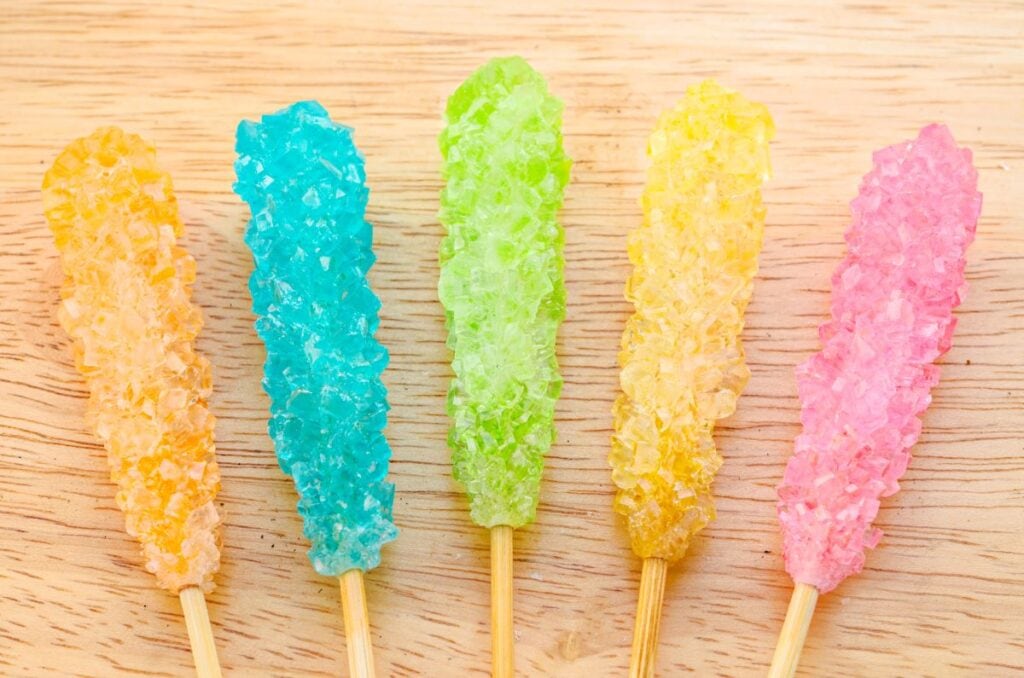
Are you looking for an engaging way to introduce kids to the world of science, technology, engineering, and math (STEM) while having a blast in the kitchen? Making rock candy at home is a delightful and educational STEM activity that not only satisfies your sweet tooth but also provides valuable learning experiences. I remember as a kid making rock candy to be one of the coolest activities but also taught me some serious patience since this doesn’t happen quickly. But hey, it’s a great way to show that not everything has the instant gratification we’re used to in today’s fast paced world.
What is Rock Candy?
Rock candy is a crystalline candy made from sugar and water. It’s known for its large, beautiful crystals that form over time. The process of making rock candy involves creating a supersaturated sugar solution, which then cools and crystallizes. This experiment is perfect for kids because it combines chemistry, patience, and a touch of magic as they watch tiny crystals transform into a sweet treat.
Materials You’ll Need
– 2 cups of granulated sugar
– 1 cup of water
– 1/2 teaspoon of food coloring (optional)
– 1/2 teaspoon of flavor extract (optional)
– Wooden skewers or strings
– Clothes pins or tape
– A clean glass jar or cup
– A saucepan
Instructions
1. Prepare the Skewers or Strings: If you’re using skewers, soak them in water for a few hours or overnight. This step helps the sugar crystals adhere better. For strings, tie them to a pencil or stick and place the stick across the top of the jar, so the string hangs down into the jar.
2. Make the Sugar Solution: In a saucepan, bring the water to a boil. Gradually add the sugar, stirring continuously until it dissolves completely. This creates a supersaturated solution, meaning it holds more sugar than it normally could at room temperature. (Great bonus science conversation right there!)
3. Add Color and Flavor: Once the sugar is dissolved, you can add a few drops of food coloring and flavor extract if you want to make your candy more exciting. Stir well to mix.
4. Cool the Solution: Allow the sugar solution to cool for a few minutes, then carefully pour it into your prepared jars or cups.
5. Grow the Crystals: Lower the skewer or string into the jar so it doesn’t touch the sides or bottom. Secure it in place using a clothespin or tape. Place the jar in a cool, undisturbed location. Crystals will start to form on the skewer or string over the next few days.
6. Observe and Enjoy: Watch as the crystals grow. It typically takes about 7 days for the crystals to form fully. Once they are ready, carefully remove them and let them dry.
Development Benefits
1. Understanding Supersaturation and Crystallization: Kids learn about the scientific principles of supersaturation—when a solution holds more solute than it normally can—and crystallization, where a substance forms solid crystals as it cools. This hands-on activity helps demystify abstract concepts in chemistry.
2. Enhancing Patience and Observation Skills: The process of growing rock candy takes time. Kids learn the value of patience and careful observation as they monitor the slow growth of the crystals. This encourages them to observe changes and draw conclusions based on what they see.
3. Encouraging Curiosity and Problem-Solving: As kids see the rock candy grow, they may have questions or ideas about how to alter the process. This stimulates their curiosity and problem-solving skills. For example, they might experiment with different colors or flavors and see how those variables affect the outcome.
4. Boosting Fine Motor Skills: Handling small materials like skewers and monitoring the setup require fine motor skills. The process of preparing the skewer, tying the string, and managing the jar helps improve these skills in young children.
5. Building Knowledge of Scientific Processes: This activity helps kids understand the scientific method. They make observations, form hypotheses (e.g., “What will happen if we add more sugar?”), and see results. This lays a foundation for understanding how scientific experiments are conducted.
6. Encouraging Creativity: Decorating the rock candy or experimenting with different flavors and colors allows children to express their creativity. They can design their own unique rock candy creations and share them with family and friends.
Making rock candy is more than just a fun kitchen experiment—it’s an opportunity for kids to delve into the fascinating world of science while enjoying a sweet reward. This activity provides a concrete way to understand abstract scientific concepts, encourages patience, and fosters curiosity and creativity. Plus, it’s a delicious way to reinforce STEM learning. So gather your materials, prepare for a bit of sweet science, and enjoy watching those rock candy crystals grow!
Rock Candy at Home
Ingredients
- 2 cups granulated sugar
- 1 cup water
- 1/2 tsp food coloring a few drops
- 1/2 tsp flavor extract optional
Instructions
- Soak skewers in water overnight if using. If using string, tie to a pencil or stick and hang across the top of a jar so that string hangs into the jar.
- In a saucepan, bring water to boil and add sugar. Continue stirring until it is fully dissolved.
- Add color and flavor.
- Allow the sugar to cool for a few minutes, then pour into prepared jar.
- Place the jar in an undisturbed location. Crystals will begin to form over the next few days.
- After about 7 days, remove the stick or string from the solution and allow the crystals to dry.
- Enjoy!